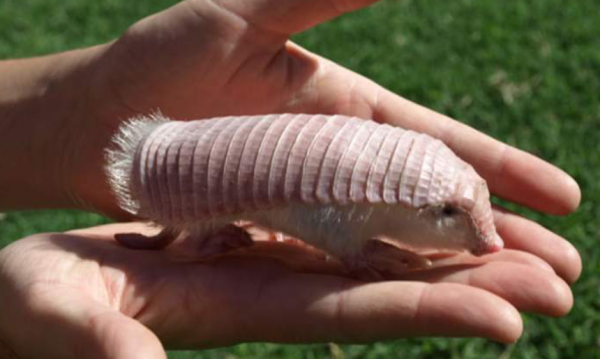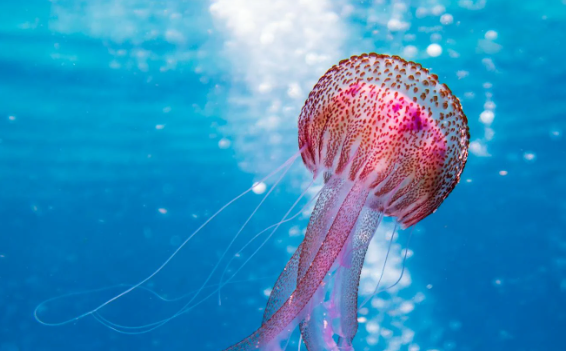Have You Ever Heard of a Pink Fairy Armadillo?

© factanimal.com
Are you a big pink person yourself? I wouldn’t be surprised! The color is so pleasing to the eye, that although you can shop for it whenever and wherever you like, you secretly wish you could witness it more. For example, what if you could see pink in nature as well? And I am not talking about man-made structures! Meet the pink fairy armadillo, a rare animal whose shell and fur are fully pink!
What Is a Pink Fairy Armadillo?
The pink fairy armadillo (Chlamyphorus truncatus) is a small and unique species of armadillo native to central Argentina. It is the smallest armadillo species known for its distinctive pinkish coloration. The pink fairy armadillo has a flexible, armor-plated shell that covers its back, head, legs, and tail. The shell is pale pink, and the animal’s fur is also pink, giving it its name.

This species is adapted for a burrowing lifestyle, with strong claws on its front limbs that it uses for digging into the sandy soils of its habitat. The pink fairy armadillo is nocturnal and feeds on insects, worms, and other small invertebrates.
Super Difficult to Encounter
Due to its secretive nature and the remote areas, the pink fairy armadillo is not frequently encountered, and there is limited information about its behavior and ecology. Additionally, the species is considered vulnerable, facing threats such as habitat destruction and human activities. Conservation efforts are important to ensure the survival of this unique and charming species.
How Does It Have a Shell and Fur?
The pink fairy armadillo possesses fine hair that aids in thermoregulation, crucial in its habitat with fluctuating temperatures. Being nocturnal in the cold Argentinian plains, the armadillo uses its fur to conserve heat during outdoor activities. Unlike other armadillos, it has a soft and flexible shell consisting of 24 bands, allowing it to curl up for protection. The armor, attached via a thin membrane, reveals blood vessels close to the surface. The animal can control its shell’s exposure to the environment for effective thermoregulation. Additionally, the shell aids in digging, preventing tunnel collapses, and the armadillo relies on its keen sense of smell for communication and locating prey.
Pink Fairy Armadillo Threats
The pink fairy armadillo faces numerous threats in its natural environment. Being a subterranean dweller, it is compelled to abandon its burrows during heavy storms to avoid drowning and prevent its fur from getting wet, which could disrupt thermoregulation and lead to hypothermia. Above ground during rainstorms, the armadillo becomes vulnerable to predators, with domestic dogs being a significant threat. Even within their burrows, they are preyed upon by dogs, cats, and wild boars.

Captivity is particularly challenging for these armadillos, with a high mortality rate during transport and very limited survival in captivity. Despite this, they are often illegally sold on the black market as pets. Susceptible to climate changes, especially cold temperatures, their low metabolism rate and inability to store fat make them at risk of population decline.
Habitat Loss Is Also an Issue
Habitat loss due to agriculture and land conversion poses a significant threat as burrows get plowed over and the altered landscape becomes unsuitable for their habitation. Pesticides used in farmlands also impact them, as ants, their primary food source, carry the pesticides. Overhunting further contributes to their endangerment, as they are hunted for consumption due to their texture and taste being likened to pork. These multifaceted challenges highlight the precarious status of the pink fairy armadillo in the wild.
Fun Facts About Pink Fairy Armadillos
Looking to find out more about the pink fairy armadillo? Here are some additional facts about this animal:
6. Their Name Has Meaning
The pink fairy armadillo, often nicknamed the “sand-swimmer,” has been a subject of intrigue among biologists who mistakenly believed it could traverse the sand in a manner similar to a fish swimming in water. However, this assumption is incorrect, as the armadillo does not swim but instead utilizes its specialized claws for burrowing into the sand. This distinctive behavior reflects its adaptation to a fossorial lifestyle, allowing the armadillo to navigate its sandy habitat through burrowing rather than swimming.
5. Their Pink Skin Is Necessary
The pink fairy armadillo’s unique shell is characterized by a pink or pale-rose coloration, attributed to a network of blood arteries behind the armor. Contrary to common armadillo shells primarily serving as a defense mechanism, the delicate and malleable nature of the pink fairy armadillo’s shell is designed primarily for temperature control. The shell features blood vessels that periodically expand or contract, enabling the regulation of the animal’s body temperature. This dynamic process not only contributes to the armadillo’s ability to maintain optimal temperatures but also imparts a distinctive rose color to its shell.

4. Their Shells Can Change Color
The pink fairy armadillo’s shell coloration is accidental upon the surrounding environment and the armadillo’s thermoregulatory capabilities. The shell can adopt a more vibrant “pink” hue when increased blood flow irrigates its carapace, facilitating heat dissipation. Conversely, the armadillo has the ability to draw blood out of the shell to retain body heat. This results in a paler appearance of the shell. This dynamic interplay between blood circulation and thermoregulation allows the armadillo to adjust its shell color in response to temperature variations in its habitat.
3. Their Bodies Are Not Connected to Their Shell
Pink fairy armadillos are characterized by their small eyes, smooth yellow-white fur, and a dorsal shell that is uniquely connected to the flesh through a delicate dorsal membrane. The dorsal shell, which is distinctively thin, is the only one among armadillo species that completely separates from the body. The armadillo’s tail, resembling a spatula, forms a vertical plate projecting from the back of its shell. The shell’s sole attachment to the body occurs where the spine runs directly along a thin membrane.
2. Their Vision Is Almost Non-Existent
The pink fairy armadillo relies on its small eyes. They primarily use their senses of touch and hearing to navigate their environment. Its compact, torpedo-shaped body is crucial for its burrowing ability, as it minimizes drag during underground digging. Despite having limited vision, the armadillo compensates effectively with its heightened tactile and auditory senses for navigation and survival.
1. Their Claws Are Used for Digging
The pink fairy armadillo features two sets of enormous claws on both its front and back legs. They are particularly large in proportion to their size. These gigantic claws, while hindering its ability to walk on surfaces other than sand and soft terrain, serve as highly efficient tools for swiftly digging burrows in compacted dirt. The specialized adaptation of these claws underscores the armadillo’s burrowing lifestyle, enabling it to navigate and create shelters with remarkable speed in its preferred sandy environment.
Endangerment and Conservation Status
The pink fairy armadillo was classified as near-threatened in 2006 but was later moved to the data deficient category in 2008 due to a lack of scientific information on its population and natural history. Field sightings are rare, and stress susceptibility makes conservation efforts challenging, especially in captivity. Attempts to modify its environment often result in stress responses, leading to unsuccessful captivity endeavors. Transportation from the wild habitat has resulted in numerous deaths, with only three successful reports of captive maintenance. The species is found in protected areas, including Lihué Calel National Park, and is safeguarded by both national and provincial legislation.
Would you ever want to see a pink fairy armadillo in real life?
You might also want to read: Rare Bright Pink Pigeon Was Seen in the UK



